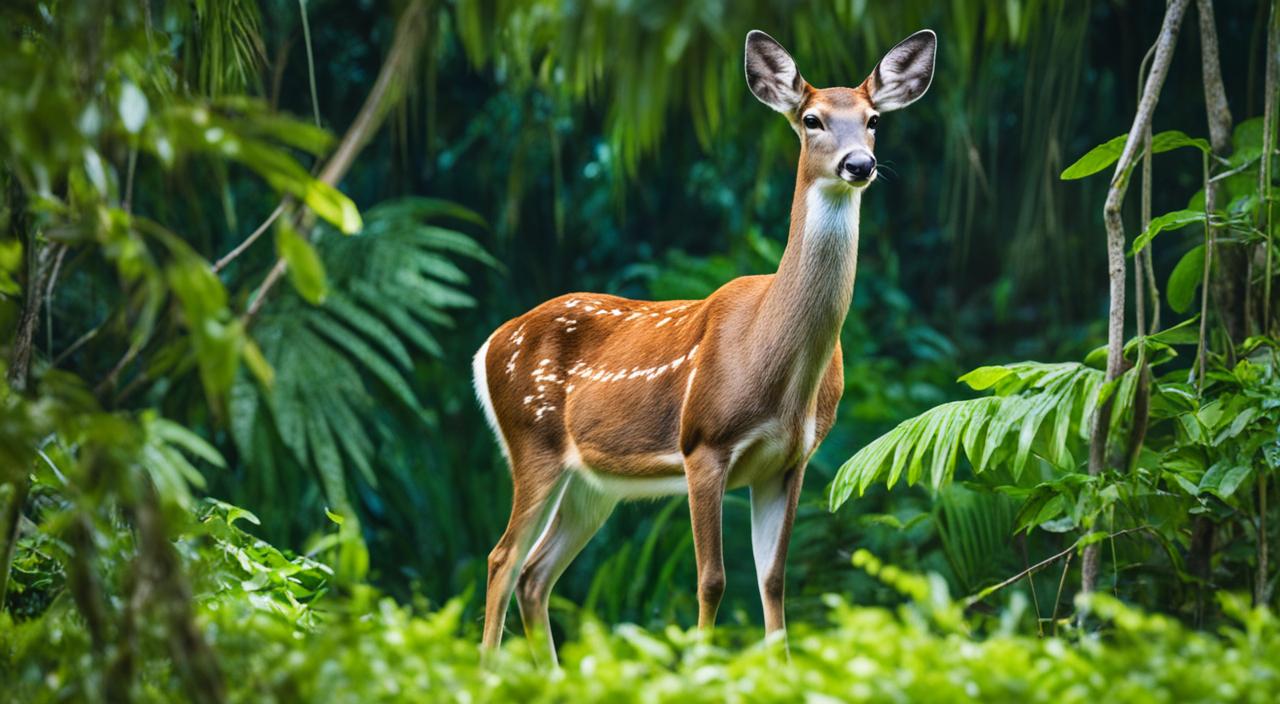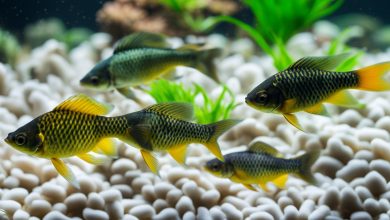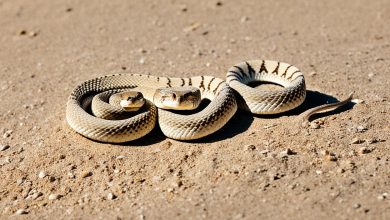The Philippine deer, also known as the Philippine sambar or Mariannan sambar deer, is very small. It stands about 60 to 70 cm tall at the shoulder. This deer is a key part of the Philippine biodiversity and is loved by many. Sadly, it is also very rare, with only 150 in captivity worldwide.
This deer, known as Rusa marianna, lives on several islands in the Philippines. These include Luzon, Polillo, Catanduanes, Mindoro, Samar, Mindanao, and Leyte. It’s smaller than other deer, with a length of 100 to 151 cm and a height of 55 to 70 cm at the shoulder. Its brown coat and white tail underside make it stand out in the Philippine fauna.
Introduction to the Philippine Deer
Taxonomy and Classification
The Philippine deer, also known as the Philippine brown deer, was first described by Anselme Gaëtan Desmarest in 1822. It was named Cervus mariannus back then. Now, it’s classified under the genus Rusa. There are four subspecies: R. m. marianna in Luzon, R. m. barandana in Mindoro, R. m. nigella in Mindanao’s uplands, and R. m. nigricans in Mindanao’s lowlands.
Physical Characteristics
The Philippine brown deer is smaller than the sambar deer. It’s 100 to 151 cm long and 55 to 70 cm tall at the shoulder. It weighs between 40 to 60 kg. Its brown fur has a white underside on its tail. Males have antlers that can be 20 to 40 cm long.
| Subspecies | Distribution |
|---|---|
| R. m. marianna | Luzon biogeographic region |
| R. m. barandana | Mindoro |
| R. m. nigella | Isolated upland areas of Mindanao |
| R. m. nigricans | Lowland sites of Mindanao |
This deer is found on islands like Luzon, Polillo, Catanduanes, Mindoro, Samar, Mindanao, and Leyte. It might be extinct on Biliran, Bohol, and Marinduque.
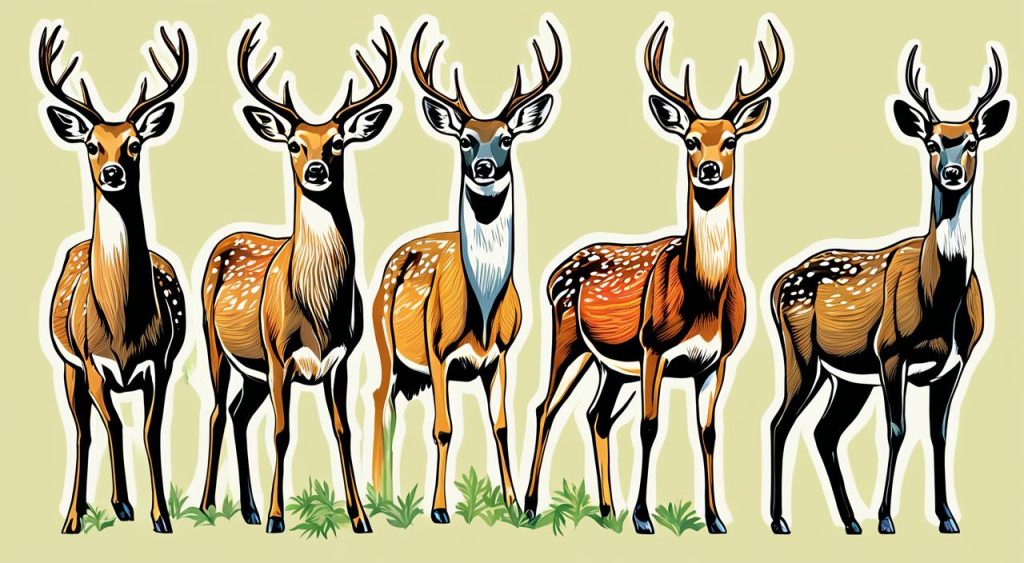
Distribution and Habitat
The Philippine deer, also known as the Philippine brown deer, is found only in the Philippines. It lives mainly on Luzon, Polillo, Catanduanes, Mindoro, Samar, Mindanao, and Leyte. It might be extinct on Biliran, Bohol, and Marinduque, and is gone from Dinagat and Siargao Islands.
This deer lives on land, from sea level up to 2,900 meters (9,500 feet) high. It likes to eat in grasslands under forests, but has lost a lot of its home. Now, it lives in the few forests left at high places.
| Conservation Status | Habitat | Distribution |
|---|---|---|
| Vulnerable | Grasslands under primary and secondary forests | Luzon Polillo Catanduanes Mindoro Samar Mindanao Leyte Possibly extinct in Biliran, Bohol, and Marinduque. Declared extinct in Dinagat and Siargao Islands. |
The Philippine deer lives from lowlands to highlands, showing it can adapt to different places. But, its numbers are very low because of habitat loss and overhunting.

Behavior and Ecology
The Philippine deer (Rusa marianna) is a fascinating species known for its nocturnal habits and diverse ecological traits. They live on land, from sea level up to 2,900 meters (9,500 feet) high. They love to forage in grasslands under forests.
Mating and Reproduction
The mating season for these deer is from September to January. During this time, females form groups of up to eight deer. Males become more vocal, aggressive, and solitary, defending their territories.
After about six months of pregnancy, a female gives birth to one fawn. This fawn has light-colored spots that fade as it grows up.
Feeding Habits
These deer are adaptable eaters, munching on grasses, leaves, fallen fruits, and berries. They are mostly nocturnal, eating at night and resting in the forest during the day. This helps them avoid the heat and predators.
| Behavior and Ecology | Characteristics |
|---|---|
| Activity Patterns | Nocturnal, foraging at night and resting in dense forests during the day |
| Habitat Preferences | Terrestrial environment from sea level up to 2,900 m (9,500 ft), preferring grasslands under primary and secondary forests |
| Mating and Reproduction | Mating season from September to January, females gather in groups of up to 8 deer, males become more vocal, aggressive, and solitary, females give birth to a single fawn with light-colored spots |
| Feeding Habits | Omnivorous, feeding on grasses, leaves, fallen fruits, and berries |
The Philippine deer’s behavior and ecological traits are key to its role in the Philippines’ wildlife. Knowing these traits is vital for conservation efforts for this endangered species.
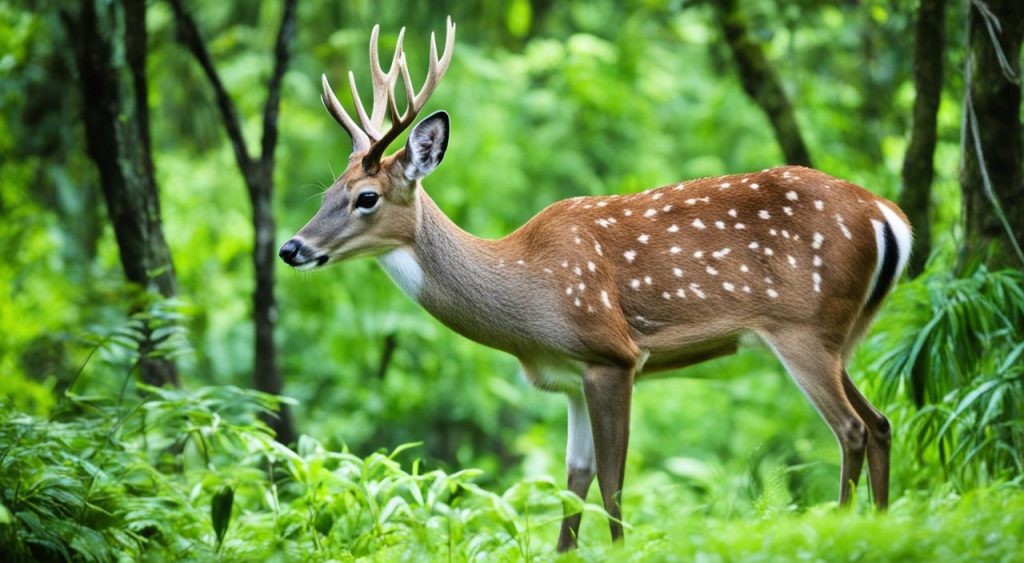
Philippine Deer: A Cultural Keystone Species
The Philippine brown deer is a key species for the Bagobo-Tagabawa tribe in Davao City. They call it a “cultural keystone species.” This title shows how important the deer is to their culture and identity. To protect it, the tribe has set up special areas for hunting and non-hunting.
The Obu Manuvu community also sees the Philippine deer as a “Pusaka” species. This means it’s very valuable to them. They work hard to keep the deer safe in their ancestral lands.
| Year | Relative Abundance Index (RAI) | Independent Detections |
|---|---|---|
| 2016 | 0.79 | 4 |
| 2020 | 0.80 | 4 |
The deer’s numbers in the Obu Manuvu area have slightly gone up. The RAI went from 0.79 in 2016 to 0.80 in 2020. There were still four independent sightings, showing the deer’s importance to the community.
But, the deer is still at risk from hunting and losing its home. This shows how vital conservation efforts are. We must protect this cultural keystone species to keep the culture of indigenous communities alive.
“The Philippine deer is not just an animal to us; it is a part of our history, our way of life, and our very identity. We are committed to ensuring its survival for generations to come.”
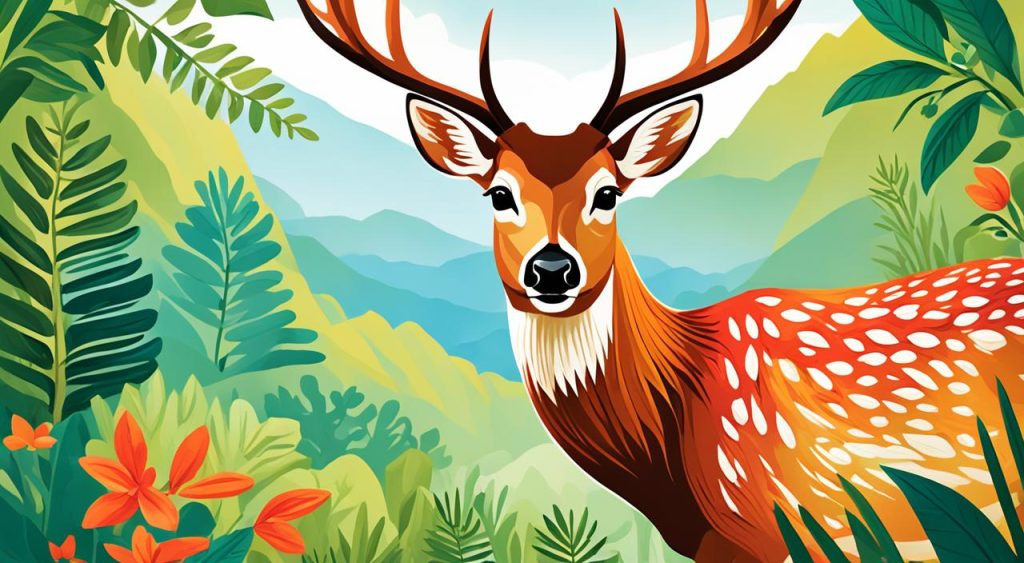
Threats to the Philippine Deer
The Philippine brown deer is a unique and important species. However, it faces many threats that are causing its numbers to drop fast. One big issue is the loss and breaking up of its natural home. As forests are cut down for development and farming, the deer are left with small, isolated areas to live in. These areas don’t have enough food and resources for the deer to survive.
Habitat Loss and Fragmentation
The deer’s home is being destroyed and broken into smaller pieces. This makes it hard for them to find the food and resources they need. They are now hiding in the little forests left, which is not enough for them.
Overhunting and Poaching
Overhunting and poaching are also big threats to the deer. Hunters want their meat, which is sold for a good price. Also, the deer’s antlers are used in traditional medicine, leading to more hunting and poaching.
This deer has a low birth rate, with only one fawn per year. This makes it very vulnerable to threats. Without strong conservation efforts, this special deer might not be around much longer.
| Threat | Impact | Consequence |
|---|---|---|
| Habitat Loss and Fragmentation | Deer forced to retreat into smaller, disconnected patches of forest | Reduced access to food and resources, leading to population decline |
| Overhunting and Poaching | Deer hunted for meat and traditional medicine | Unsustainable hunting practices, further reducing the already vulnerable population |
| Low Fertility Rate | Single fawn born in each conception | Inability to quickly recover from population losses, making the species more susceptible to extinction |
“The Philippine brown deer, a unique and culturally significant species, faces several grave threats that contribute to its rapidly declining population.”
Conservation Efforts and Status
The Philippine spotted deer, known as Rusa alfredi, is a rare and native deer species. It’s listed as Endangered by the IUCN. Over the past 24 years, its population has dropped by over 30%. This decline is due to overhunting, habitat loss, and fragmentation.
There are efforts to protect and bring back the Philippine spotted deer. Local communities have set aside areas for hunting and non-hunting. Also, programs are in place to manage deer populations where they’ve been introduced, like Guam.
The “Enhancing the conservation and breeding program of the Philippine spotted deer, Rusa alfredi” project was launched by DOST-PCAARRD. It aims to grow the deer population. The project uses molecular science to boost the deer’s resilience and supports the DENR in reintroducing them to their natural habitats in Negros-Panay Island.
Silliman University is leading the conservation efforts for the Philippine spotted deer. Dr. Robert S. Guino-o and Dr. Aye Mee F. Bartocillo are at the helm. They’re studying the deer’s genetics, inbreeding levels, and immune responses to help conservation.
Even with challenges, saving the Philippine spotted deer is crucial. Ongoing projects aim to raise awareness and boost its numbers. This species is unique and needs our help.
| Key Facts | Values |
|---|---|
| IUCN Threatened Status | Endangered (EN) |
| Number of Philippine Spotted Deer in Captivity | Around 150 |
| Number of Philippine Spotted Deer in the Wild (1987) | Fewer than 100 |
| Forest Coverage on Panay Island | Decreased from 90% to 7% |
| Number of Breeding Stations | Three |
| Size of Panay Mountain National Park | Approximately 60,000 hectares |
| Size of Negros Reserve | 300 hectares |
“The conservation of the Philippine spotted deer remains a top priority, and the ongoing efforts aim to increase awareness and restore the population of this unique and threatened species.”
The Philippine Deer in Prehistoric Times
The Philippine deer’s story goes way back to prehistoric times. Back then, the Philippines might have been linked to the Sunda island of Borneo during ice ages. Fossils found in Ille Cave in Palawan show us that this special deer was around.
Fossil Record and Evidence
At Ille Cave in Palawan, archaeologists found many fossils. These fossils show that deer lived with other animals like tigers, monkeys, bearded pigs, and small mammals. During the Terminal Pleistocene and early Holocene periods.
Studies of these fossils suggest there were two kinds of deer. One of them is very similar to the Philippine brown deer (Cervus or Rusa marianna) we see today.
But, the deer in Mindanao are quite different. This makes us wonder if the Palawan fossils might belong to a deer that is now extinct. This shows we need more research to understand the paleoecology and evolution of the Philippine deer.
The fossil record tells us a lot about the prehistoric life and biodiversity of the Philippine deer. It helps us understand how it evolved and adapted to the different environments of the Philippines over time.
“The fossil evidence from Ille Cave suggests the Philippine deer has a long and dynamic history, with the potential for undiscovered species or subspecies waiting to be uncovered.”
Importance of Conserving the Philippine Deer
Keeping the Philippine deer safe is key to protecting the country’s unique biodiversity and ecosystem. This deer is a cultural keystone species for indigenous communities. They see it as a “Pusaka” species, deeply tied to their traditions and life.
Protecting the deer helps keep the nation’s natural heritage safe. It also helps keep the rich cultural diversity alive.
The Philippine Spotted Deer is listed as Vulnerable on the IUCN Red List. Its numbers have dropped by over 30% in the last 24 years. This decline is mainly due to habitat loss and fragmentation, and overhunting and poaching.
We need strong conservation efforts to save this endemic species. This will help keep its natural environment balanced.
Breeding programs, like those by the Talarak Foundation Inc., show promise. They’ve released deer into a protected area on Negros with good results. The Panay Mountain National Park has also become a key habitat for the deer, offering hope for its future.
“The Philippine deer is not just an animal, but a living embodiment of our cultural identity and heritage. Protecting this species is not just a matter of conservation, but a responsibility to our ancestors and future generations.”
By saving the Philippine deer, we protect a vital part of the country’s biodiversity and ecosystem. We also keep the cultural legacy of indigenous communities alive. As caretakers of the earth, it’s our duty to help the Philippine deer and the life it represents.
Future Outlook and Challenges
The future of the Philippine deer is uncertain due to conservation challenges. We need to tackle habitat loss, fragmentation, and poaching head-on. This means working on habitat restoration, improving anti-poaching efforts, and keeping the community involved.
Working together is key. The government, conservation groups, and local communities must join forces. This way, we can protect the Philippine deer and keep our natural heritage safe for the future.
Even with efforts in place, the Philippine deer is still at risk. There are only about 900 Calamian deer left, making them endangered. Deforestation and urban growth are taking over their homes.
Poaching is another big problem, with many species facing extinction. We need to boost anti-poaching efforts. This includes more patrols and enforcing laws to protect wildlife.
Getting local communities involved is crucial. Educating them about the importance of these animals can create a sense of responsibility. This support is vital for their survival.
Our success in saving the Philippine deer depends on tackling these conservation challenges well. With teamwork, new ideas, and a strong commitment to habitat restoration and anti-poaching, we can ensure the deer’s future.
Key Facts About the Philippine Deer
The Philippine deer, also known as the Philippine sambar or Philippine brown deer, is a vulnerable deer species found only in the Philippines. It is smaller than the sambar deer. It has a head-and-body length of 100 to 151 cm, stands 55 to 70 cm tall at the shoulder, and weighs 40 to 60 kg.
This deer lives on several islands in the Philippines, like Luzon, Polillo, Catanduanes, Mindoro, Samar, Mindanao, and Leyte. Its home is under threat from habitat loss, fragmentation, and overhunting. These threats have put it on the Vulnerable (VU) list of the IUCN.
Efforts are being made to save the Philippine deer. Government agencies and local communities are working together. They are creating protected areas and breeding stations to help the deer recover. The deer’s population in zoos is stable, offering hope for its future. Yet, there are still big challenges to protect this unique Philippine wildlife.
FAQ
What is the Philippine deer?
The Philippine deer, also known as the Philippine sambar or Philippine brown deer, is a vulnerable deer species found only in the Philippines.
What are the key physical characteristics of the Philippine deer?
This deer is smaller than the sambar deer. It has a head-and-body length of 100 to 151 cm. Its shoulder height is 55 to 70 cm, and it weighs 40 to 60 kg. It’s mostly brown with a white tail underside. Males often have antlers that are 20 to 40 cm long.
Where is the Philippine deer found?
It’s found on several islands in the Philippines. These include Luzon, Polillo, Catanduanes, Mindoro, Samar, Mindanao, and Leyte.
What is the conservation status of the Philippine deer?
The Philippine deer is listed as Vulnerable (VU) by the IUCN. This is because its numbers are dropping fast. This is due to too much hunting, losing its habitat, and its habitat getting broken up.
How do the Philippine deer behave and what do they eat?
They are mostly active at night. They look for food like grasses, leaves, fruits, and berries then. In the day, they rest in the dense forest.
What is the cultural significance of the Philippine deer?
The Philippine deer is very important to the Bagobo-Tagabawa tribe and the Obu Manuvu community. They see it as a “cultural keystone species” and a “Pusaka” species. This shows how important it is to their culture, traditions, and life.
What are the main threats to the Philippine deer?
The main threats are losing its habitat and being hunted too much. People hunt it for its meat and antlers, which are used in traditional medicine.
What conservation efforts are being made to protect the Philippine deer?
Efforts include setting up hunting and non-hunting zones by local communities. There are also programs to manage the deer population in places like Guam.
What is the prehistoric history of the Philippine deer?
Fossils found in Ille Cave in Palawan show deer and other animals lived there during the Terminal Pleistocene and early Holocene. These fossils suggest there might have been an extinct deer species related to the Philippine brown deer.
